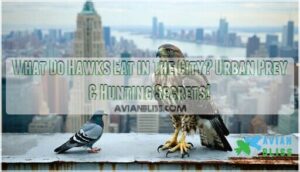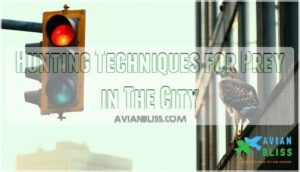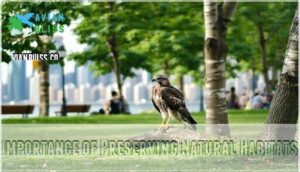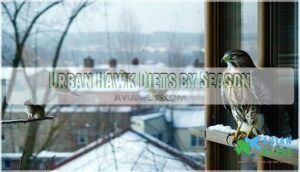This site is supported by our readers. We may earn a commission, at no cost to you, if you purchase through links.
 You’ll find urban hawks are resourceful hunters who’ve adapted their menu to city life.
You’ll find urban hawks are resourceful hunters who’ve adapted their menu to city life.
They primarily target pigeons, sparrows, and mourning doves – think of them as nature’s pest control service.
They’ll also snatch up rats, squirrels, and small mammals that thrive in concrete jungles.
Unlike their rural cousins who hunt in open fields, city hawks have learned to navigate buildings and power lines like aerial acrobats.
They’re opportunistic feeders, meaning they’ll grab whatever’s available, from insects to small reptiles.
Understanding what do hawks eat in the city reveals fascinating hunting strategies that might surprise you, and shows how they are opportunistic feeders.
Table Of Contents
- Urban Hawk Diets
- Common Prey for Urban Hawks
- Unique Urban Hawk Prey
- Challenges for Urban Hawks
- Impact of Pollution on Urban Hawks
- Importance of Preserving Natural Habitats
- Hunting Techniques of Urban Hawks
- Diet of Baby Hawks in The City
- Urban Hawk Diets by Season
- Attracting Hawks to Your Urban Backyard
- Frequently Asked Questions (FAQs)
- What does it mean when a hawk hangs around your yard?
- What attracts hawks to your yard?
- What is hawk’s favorite food?
- Can a hawk pick up a 10 lb cat?
- Do hawks eat birds?
- What do sharp-shinned hawks eat?
- What do white tailed hawks eat?
- Are Hawks carnivores?
- What is hawks Favourite food?
- Are hawks good to have around?
- Conclusion
Urban Hawk Diets
You’ll find that urban hawks have adapted their hunting strategies to target the abundant city prey like pigeons, rats, and squirrels that thrive in concrete jungles.
Hawks have become the ultimate urban opportunists, trading forest rabbits for city rats with remarkable hunting precision.
These feathered predators have basically become the neighborhood’s cleanup crew, switching from rural rabbits to urban rodents while maintaining their razor-sharp hunting skills.
Types of Prey in City Environments
Throughout urban landscapes, City Hunters discover remarkable Prey Diversity that fuels their survival.
These adaptable raptors have mastered Urban Foraging, targeting three primary categories:
- Abundant birds – pigeons, sparrows, and mourning doves dominate the city hawk diet
- Prolific mammals – rats, squirrels, and occasional rabbits provide protein-rich meals
- Opportunistic catches – insects, bats, and small reptiles round out their hawks prey list
This varied Urban Prey showcases nature’s incredible adaptability.
Adaptation to City Life and Food Sources
Hawks have mastered urban foraging by switching from rural reptiles to city staples.
You’ll spot them eyeing rats and pigeons instead of their traditional woodland prey.
This food adaptation represents nature’s remarkable flexibility—they’ve traded snake hunting for city scavenging around dumpsters and parks.
Urban nesting hawks develop different hunting rhythms, targeting abundant city bird prey during peak activity hours.
Their urban bird diet now includes more protein-rich rats than their rural cousins enjoy.
Hawks in cities exploit concentrated food sources, making urban hawk food surprisingly diverse.
City hawk diet patterns show they’re opportunistic survivors, not picky eaters stuck in old habits.
Urban Hawks
Primary Prey
Hunting Spots
Adaptation Strategy
Impact of Urbanization on Hawk Diets
City living has fundamentally reshaped hawk hunting habits and Urban Prey preferences.
Human Impact creates both opportunities and challenges – Food Scarcity in some areas forces hawks to expand their diets, while abundant city bird prey in others supports thriving populations.
City Nesting hawks develop broader tastes than rural cousins, with urban hawk food including everything from rats to pigeons.
This dietary flexibility helps city hawk species thrive despite concrete jungles, though urban wildlife food availability varies dramatically by neighborhood and season.
- Hawks in cities eat 40% more bird species than rural hawks
- Urban environments create year-round food sources unavailable in wilderness
- Hawk Migration patterns shift as cities provide reliable winter prey
Comparison to Rural Hawk Diets
Rural vs. urban hawk feeding habits reveal fascinating contrasts in prey selection and hunting strategies.
City hawks adapt their diets based on available resources.
- Rural Diet: Focuses on natural prey like voles, field mice, and native songbirds in open landscapes
- Urban Adaptation: Shifts to pigeons, rats, and backyard birds due to habitat differences
- Prey Comparison: City hawk species show broader dietary flexibility than their countryside counterparts
Common Prey for Urban Hawks
You’ll find urban hawks targeting the same animals you see daily on city streets: pigeons pecking at crumbs, squirrels darting across sidewalks, and rats scurrying through alleys.
These adaptable predators have learned to exploit the abundance of small mammals and birds that thrive alongside human populations, making city life surprisingly productive for hunting.
Pigeons and Squirrels
You’ll spot hawks circling overhead, eyeing their favorite city meals.
Pigeons dominate urban hawks diet, offering abundant protein with predictable Pigeon Behavior patterns. These city bird species gather in flocks, making them easy targets.
Squirrels provide tougher challenges, using Squirrel Habitats like park trees for escape routes.
This Urban Foraging creates dynamic City Ecosystems where what hawks eat depends on prey availability and cunning.
Rats and Small Birds
When darkness falls, you’ll notice these City Hunters shift their focus to abundant Urban Prey like rats and small songbirds.
Red-tailed hawks in Manhattan have become expert at Rodent Control, with studies showing rats comprise 70% of their urban hawks diet.
You’ll spot them targeting sparrows, starlings, and finches during Bird Feeding frenzies at parks.
These birds of prey capitalize on city bird species that flock to feeders and garbage areas.
Understanding what hawks eat reveals how hawks city diet adapts perfectly to metropolitan abundance, making Hawk Migration less necessary when food sources remain consistent year-round.
Hunting Techniques for Prey in The City
Hawks transform into urban ninjas when hunting city prey, using sophisticated stealth tactics that’d make any predator jealous.
These aerial attacks showcase remarkable adaptability:
- Perch Hunting: Station themselves on buildings, scanning for movement below
- Urban Stalking: Navigate traffic patterns while tracking prey through streets
- City Ambush: Strike from unexpected angles using reflective surfaces
- Stealth Tactics: Blend seamlessly with urban architecture
Hawks also utilize clever strategies like traffic signal hunting to catch their prey off guard in the city.
Unique Urban Hawk Prey
You’d be surprised to find hawks in cities capturing bats during their evening flights and snatching insects like grasshoppers from park lawns.
These urban predators have expanded their menu beyond typical prey, now hunting fish from shallow ponds and even targeting rabbits that venture into city green spaces.
Insects and Fish in Hawk Diets
You might be surprised to learn that urban hawks practice opportunistic Urban Foraging beyond their typical bird and rodent menu.
Insect Consumption becomes particularly important for species like Swainson’s hawks, who actively hunt grasshoppers in city parks and green spaces.
Meanwhile, Aquatic Hunting occurs when hawks target shallow water sources for small fish and crustaceans, demonstrating remarkable dietary flexibility in urban environments.
| Insect Prey | Fish Prey |
|---|---|
| Grasshoppers | Koi |
| Beetles | Small fish |
| Dragonflies | Crabs |
| Crickets | Crawfish |
| Moths | Amphibians |
Urban Hawks Eating Bats and Other Small Mammals
Beyond catching pigeons, you’ll witness urban hawks mastering bat predation through remarkable hawk adaptations.
These city wildlife eating specialists use twilight urban hunting techniques, snatching bats mid-flight with precision timing.
Small mammal prey like rats and mice also feature prominently in their city foraging repertoire.
Such bird eating habits demonstrate how hawks in cities expertly exploit available urban prey sources.
Hawks also engage in scavenging behavior to survive in urban environments.
Rabbits and Other Unusual Prey Items
Rabbit predation represents one of urban hunting’s most surprising adaptations. You’ll discover unusual prey choices that showcase remarkable hawk adaptation in city environments.
Small mammals like rabbits thrive in parks and green spaces, creating opportunities for hawks in cities to diversify their diets beyond typical rodents and birds.
- Rabbits provide substantial protein compared to smaller urban prey
- City food chain dynamics shift when hawks target larger mammals
- Urban hawks demonstrate flexibility by hunting ground-dwelling species
This hawk city ecosystem reveals nature’s incredible adaptability.
Challenges for Urban Hawks
When you observe hawks in cities, you’ll notice they face far more obstacles than their rural cousins, from competing with other predators for limited prey to dodging cars and dealing with toxic pollution that affects their health.
These urban challenges force hawks to adapt their hunting strategies, often pushing them to hunt at night when competition decreases and prey becomes more accessible, which is a significant change in their behavior to overcome the difficulties of city life, including the need to avoid cars.
Competition for Food Sources
Urban hawks face fierce prey competition in city environments where food scarcity creates constant challenges.
You’ll notice domestic cats hunting the same small birds that hawks target, while owls compete for rodents during overlapping hunting hours.
Invasive species disrupt the natural city food chain, forcing urban hawks into hawk rivalry situations.
| Competitor Type | Primary Impact | Affected Prey |
|---|---|---|
| Domestic Cats | Reduced songbird populations | Sparrows, finches |
| Urban Owls | Nocturnal rodent competition | Rats, mice |
| Invasive Birds | Territory displacement | Various small birds |
| Other Hawks | Direct resource management conflicts | All available prey |
| Human Activity | Habitat disruption | Urban foraging opportunities |
This resource management struggle shapes their urban foraging strategies substantially, leading to constant challenges and urban foraging adaptations.
Exposure to Toxins and Pollution
City hawks face serious environmental risks from pollution and toxins that infiltrate their urban diet.
Chemical exposure from rodenticides in prey creates cascading pollution effects throughout the food chain.
These urban hazards damage respiratory systems and reproductive success.
Toxic food sources, contaminated by industrial emissions and pesticides, reduce hawk populations.
You’ll notice fewer vibrant feathers on city birds due to these persistent toxins.
Nocturnal Hunting to Avoid Competition
When daylight brings fierce competition from other predators, you’ll find urban hawks switching to nocturnal hunting strategies.
Their exceptional night vision and stealth tactics let them navigate city landscapes under cover of darkness.
Using urban camouflage and shadow stalking techniques during moonlight hunting sessions, these adaptable raptors access abundant prey like rats and mice.
This behavioral shift demonstrates how city bird ecosystem dynamics force innovative hunting techniques that maximize prey availability while minimizing direct competition.
Impact of Pollution on Urban Hawks
You’ll notice that urban hawks face serious health risks from the toxins they encounter in city environments, much like how we worry about air quality affecting our own well-being.
These pollutants accumulate in their prey and directly impact the reproductive success, immune systems, and overall survival rates in ways that researchers can measure and document.
Health Problems From Toxins
Beyond competition for prey, toxic exposure creates serious hawk diseases that threaten urban hawk health.
Poisoning risks from contaminated rodents carrying anticoagulant rodenticides cause internal bleeding, while urban pollution delivers toxic effects through lead and persistent organic pollutants.
These toxins disrupt reproduction and nervous systems, reducing survival rates.
You’ll notice rehabilitation centers treating more cases annually:
- Lead contamination damages neurological functions
- Anticoagulant rodenticides cause fatal bleeding
- Persistent pollutants disrupt hormone balance
- Pesticide avoidance becomes impossible in cities
The use of rodent poison risks is a significant concern for urban hawk populations.
Importance of Reducing Pollution in Cities
You can help hawks thrive by supporting Green Initiatives that tackle Pollution Effects head-on.
Urban Planning that prioritizes clean air directly benefits these natural pest controllers. When cities reduce toxins, hawks maintain their sharp hunting abilities and ecosystem impact.
Sustainable Cities with better air quality create healthier urban habitats where Wildlife Conservation flourishes naturally.
Wildlife Rehabilitation Centers for Hawks
Wildlife rehabilitation centers serve as urban hawks’ lifelines when pollution takes its toll.
These bird sanctuaries provide specialized wildlife care through proven rehabilitation methods:
- Toxin detox protocols removing heavy metals from hawk systems
- Nutritional therapy restoring proper hawk diet balance
- Flight conditioning rebuilding strength for city environment survival
- Hawk conservation programs tracking release success rates
Professional hawk rescue teams guarantee these raptors return stronger.
Importance of Preserving Natural Habitats
You can protect urban hawks by preserving green spaces that support both predators and their prey populations.
These natural habitats provide essential hunting grounds and nesting sites that hawks need to thrive in city environments.
Preserving Green Spaces for Hawks and Prey
Pollution threatens urban hawks, but green spaces offer sanctuary.
You’ll find these areas support diverse prey populations while providing hunting grounds and nesting sites.
Urban planning that prioritizes wildlife conservation creates ecosystem balance through strategic habitat placement.
| Green Space Type | Prey Species Supported | Hawk Conservation Benefit |
|---|---|---|
| City Parks | Squirrels, songbirds, rodents | Primary hunting territory |
| Tree-lined Streets | Small birds, insects | Flight corridors |
| Vacant Lots | Rabbits, mice, reptiles | Undisturbed foraging |
| Rooftop Gardens | Insects, small mammals | Elevated perching sites |
| Waterfront Areas | Fish, amphibians, waterfowl | Diverse food sources |
These urban oases maintain prey diversity while giving city environment hawks the resources they need to thrive.
Creating Hawk-Friendly Environments
Creating hawk-friendly environments requires thoughtful urban planning that supports both predators and their prey.
You can advocate for designs that enhance hawk diet diversity while promoting urban hawk behavior adaptations.
Consider these eco friendly designs for wildlife preservation:
- Native vegetation: Plant species that attract rodents and songbirds
- Green corridors: Connect parks to expand hunting territories
- Reduced pesticides: Protect urban food sources from contamination
- Building perches: Add hawk-friendly rooftop structures
Incorporating Hawk Friendly plants into urban landscapes can also contribute to a thriving ecosystem.
Impact of Habitat Loss on Urban Hawks
Urban sprawl creates a domino effect that you can observe throughout city landscapes.
Habitat Destruction from aggressive Urban Planning transforms essential hunting grounds into concrete jungles, leaving urban hawks scrambling for survival.
Ecosystem Disruption follows quickly, as Biodiversity Loss eliminates the prey species these raptors depend on.
You’ll notice how habitat loss in the city environment forces hawks to compress their territories, intensifying competition for limited resources.
Prey availability plummets when green spaces disappear.
Wildlife Conservation efforts must prioritize creating urban wildlife corridors that connect fragmented habitats, giving these magnificent predators the breathing room they desperately need.
Hunting Techniques of Urban Hawks
You’ll notice urban hawks have mastered four distinct hunting methods that make them incredibly effective city predators.
These techniques include aerial pursuit, cooperative hunting, high and low soaring patterns, plus the classic hover-and-pounce and perch-and-swoop strategies that work perfectly among skyscrapers and busy streets.
Aerial Pursuit and Cooperative Hunting
Above the city’s concrete canyons, hawks demonstrate remarkable aerial tactics through cooperative hunting strategies.
These urban predators work together, executing synchronized aerial pursuit maneuvers that showcase their advanced hunting techniques.
Urban hawks employ these sophisticated flight maneuvers:
- Pincer movements to trap prey between hunters
- High-speed dives coordinated for maximum impact
- Distraction techniques where one hawk flushes prey
- Tag-team pursuits maintaining constant pressure on targets
Hawks also exhibit unique cooperative hunting behaviors that enhance their success rates in various environments.
High Soaring and Low Soaring Techniques
Beyond aerial pursuit, you’ll witness urban hawks employing high soaring and low soaring techniques as their primary hunting strategies.
High soaring maximizes energy efficiency—hawks ride thermals at impressive soaring heights, scanning vast territories with minimal wing beats.
Low soaring hugs rooftops and tree lines, where flight patterns become stealthy approaches.
These contrasting aerial tactics showcase how urban hawks adapt elevation to match prey behavior and environmental conditions.
Hover and Pounce and Perch and Swoop Methods
When city life demands precision, urban hawks master two essential hunting tactics that turn concrete jungles into hunting grounds.
These aerial attacks showcase remarkable adaptability in metropolitan environments.
Urban perches become strategic command centers for successful prey capture:
- Hover and pounce: Hawks suspend mid-air, scanning below before diving
- Perch and swoop: Patient observation from elevated urban perches, then swift descent
- Flight strategies: Combining aerial pursuit with sudden directional changes
- Hunting techniques: Adapting traditional methods for city-specific challenges
Diet of Baby Hawks in The City
You’ll notice baby hawks in cities start with tiny prey like insects and small birds before graduating to rats and pigeons as they grow stronger.
Their parents teach them to hunt urban prey through careful demonstration, showing young hawks how city environments offer different food sources than rural areas.
Transition From Small to Large Prey
Prey size selection evolves as juvenile hawks master their hunting skills through practice.
You’ll notice parental influence guides this learning curve, with adults initially providing small insects and songbirds before introducing rodents and rabbits.
This dietary expansion reflects juvenile hunting success rates—young hawks gradually tackle larger small mammals as their confidence grows, creating a natural progression toward independent diet management.
Importance of Parental Teaching
Parent hawks serve as master teachers, passing down essential hunting skills and survival strategies to their urban offspring.
You’ll witness dedicated adults demonstrating territory defense while guiding youngsters through prey identification techniques. This parental teaching shapes their diet preferences and hunting success in city environments.
Like their parents, baby hawks resemble pale downy versions.
Urban hawks teach their young through hands-on demonstrations:
- Rodents hunting techniques using stealth and patience
- Prey identification skills for spotting pigeons and squirrels
- Territory defense strategies around nesting areas
- Survival strategies for traversing urban obstacles
- Nest building fundamentals for future breeding success
Impact of Urban Environment on Baby Hawk Diets
Through concrete and steel jungles, baby hawks face tough odds surviving their first months.
Urban environments limit prey availability, forcing chicks to rely heavily on parental care for longer periods.
Toxin exposure from city pollution slows growth rates compared to rural nestlings.
When rodents and songbirds become scarce, baby hawks’ diet suffers, making urban survival a real challenge, due to the lack of available prey, which is a significant factor in their growth rates.
Urban Hawk Diets by Season
You’ll notice urban hawks adjust their hunting patterns throughout the year as prey availability shifts with each season.
Winter brings concentrated rodent activity around heated buildings, while spring and summer offer abundant young birds and increased insect populations that supplement their diet, allowing them to adapt to the changing season.
Changes in Prey Availability by Season
Watching urban hawks navigate seasonal prey shifts reveals nature’s incredible adaptability.
Winter food scarcity forces these raptors to rely heavily on rats and pigeons, while breeding season diets expand dramatically.
Migration impact disrupts established hunting patterns, yet urban adaptation allows hawks to exploit changing food sources year-round.
Here’s what you’ll observe throughout the seasons:
- Spring abundance – Nesting birds and emerging mammals create a feast
- Summer competition – Young fledglings intensify the hunt for resources
- Fall shifts – Migratory patterns reshape available prey populations
- Winter survival – Harsh conditions demand creative foraging strategies
Adaptations to Seasonal Changes
Urban hawks transform into seasonal shapeshifters, mastering dietary shifts that’d make any survivalist jealous.
When migration patterns shuffle prey availability, they don’t panic—they pivot. During breeding season, you’ll spot them targeting protein-rich mammals for growing chicks.
Come winter, their diet flips to whatever’s moving: pigeons, rats, even carrion when fresh food sources vanish. These hunting masters read seasonal changes like weather forecasts, switching tactics faster than you change clothes.
Temperature effects shape their prey choices, influencing hunting strategies. Winter survival isn’t luck—it’s pure adaptation genius in concrete jungles.
Importance of Year-Round Food Sources
Hawks in urban environments desperately need consistent food sources throughout every season to survive city life’s unpredictable challenges.
Your neighborhood’s year-round prey availability directly impacts hawk populations:
- Stable Prey Base: Pigeons and rats provide reliable nutrition during harsh months
- Winter Food Scarcity: Forces hawks to expand hunting territories and adapt techniques
- Breeding Season Needs: Abundant food guarantees successful reproduction and chick development
- Juvenile Survival Rates: Depend heavily on accessible urban food sources for inexperienced hunters
Urban planning impact determines whether hawks thrive or struggle in your city.
Attracting Hawks to Your Urban Backyard
You can create a hawk-friendly backyard by establishing a reliable food web that supports their natural prey species.
When you provide water sources, dense shrubs for small birds, and avoid using pesticides, you’re building an ecosystem that naturally attracts these magnificent raptors to your urban space, creating a reliable food web that supports their natural prey species.
Providing Food Sources for Hawks
You can create an irresistible buffet for urban hawks by attracting prey to your yard.
Install bird feeders filled with seeds to draw songbirds and squirrels – prime hawk food sources. Add water sources like shallow basins or fountains to support rodents and birds.
Plant native shrubs that provide nesting sites and safe havens for small animals. Consider different feeder styles to attract a variety of birds.
Skip pesticides that poison the diet chain. These simple steps transform your space into hawk-friendly habitat.
Tips for Attracting Hawks to Your Yard
Building on food sources, you can transform your space into a hawk haven with these proven strategies:
- Install tall perches like dead snags or poles for hunting vantage points
- Maintain water sources through birdbaths or shallow fountains for drinking
- Avoid poisons that eliminate natural prey like rodents and small birds
- Create nesting sites using native trees or platform boxes in quiet corners
These hawk-friendly backyards support natural pest control.
To enhance your hawk habitat, consider exploring options for hawk perches for sale.
Frequently Asked Questions (FAQs)
What does it mean when a hawk hangs around your yard?
It’s no accident a hawk lingers in your yard—it likely spots prey like squirrels, rodents, or small birds.
Hawks also appreciate high perches for hunting.
Their presence reflects a thriving local ecosystem.
What attracts hawks to your yard?
A steady food supply like bird feeders, outdoor pet food, or small animals attracts hawks.
They’re drawn to open spaces for hunting, tall trees or poles for perching, and minimal human disturbance for nesting.
What is hawk’s favorite food?
Hawks love variety, but their favorites often include small mammals like squirrels and rabbits, or birds like pigeons and sparrows.
Their diet depends on what’s available, showcasing their adaptability and sharp hunting instincts.
Can a hawk pick up a 10 lb cat?
A hawk can’t carry a 10-pound cat—it’s simply too heavy.
Hawks typically lift prey under 5 pounds.
So, while your cat might intrigue a hawk, it’s not at risk of being snatched.
Do hawks eat birds?
Absolutely, they do!
Birds are a key part of a hawk’s diet.
From sparrows to pigeons, hawks expertly hunt them using speed and precision.
It’s like nature’s version of an aerial chess match!
What do sharp-shinned hawks eat?
Imagine a sharp-shinned hawk like a shadowy thief in the sky, snatching small songbirds, especially near bird feeders.
They’ll also munch on insects or mammals, but their menu revolves around stealthy bird hunting.
What do white tailed hawks eat?
You’d find white-tailed hawks dining on a mix of small mammals like rabbits and rodents, birds, reptiles, and large insects.
They adapt well, taking whatever the environment serves, much like versatile chefs of the skies.
Are Hawks carnivores?
Hawks are pure carnivores, thriving on a diet of meat.
From rodents to birds and even snakes, they’re nature’s hunters, relying on sharp talons and keen eyesight to catch prey.
What is hawks Favourite food?
It’s no accident hawks favor small mammals like squirrels and rabbits or birds like pigeons and sparrows.
Their sharp talons and keen eyesight make these abundant, easy-to-catch prey a perfect fit for their urban menu.
Are hawks good to have around?
Hawks are great to have around! They naturally control pests like rats and pigeons, helping urban ecosystems thrive.
Their sharp hunting skills balance local wildlife, though small pets might need extra protection in their presence, as they are a key part of the ecosystem with sharp skills.
Conclusion
Picture hawks as the city’s silent guardians, weaving through skyscrapers to keep urban ecosystems in balance.
By understanding what do hawks eat in the city, you uncover how these adaptable predators thrive on pigeons, rats, and even insects.
Their resourcefulness highlights nature’s resilience amidst concrete landscapes.
Supporting green spaces and reducing pollution guarantees hawks continue their essential role.
Next time you spot one soaring overhead, remember they’re not just hunters—they’re urban survivalists shaping city life.
- https://www.allaboutbirds.org/guide/Coopers_Hawk/id
- https://en.wikipedia.org/wiki/Sharp-shinned_hawk
- https://ca.audubon.org/news/birds-suffer-air-pollution-just-we-do
- https://www.reconnectwithnature.org/news-events/the-buzz/nature-curiosity-why-are-some-animals-nocturnal/
- https://animals.sandiegozoo.org/animals/red-tailed-hawk
















